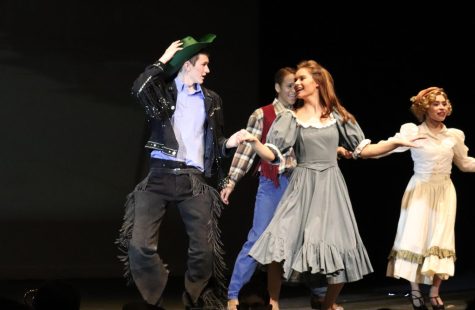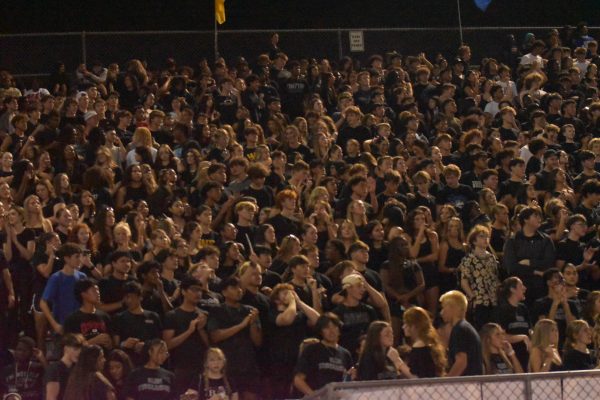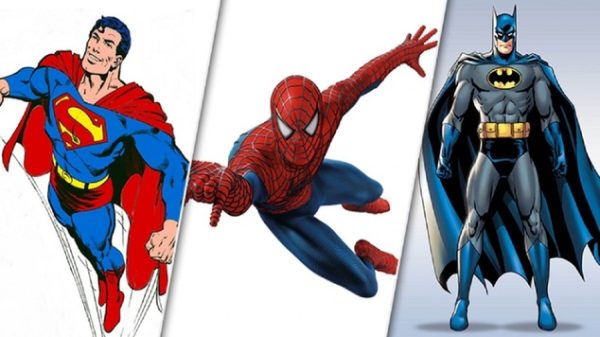Drama achieves dream with Les Misérables performances
Part of the cast of Les Misérables at the conclusion of one of the performances.
The drama department presented its production of the famous musical “Les Misérables” on Jan 23, 24, 29, 30, 31 and Feb 2, in the brand new Klein High School Performing Arts Center. Pulling from a large range of student talent, this production should be the new standard for Klein performances.
Before each performance, the audience would walk in the auditorium, greeted by the orchestra warming up and playing pieces from the musical, as well as the “Les Misérables” poster being projected onto the closed curtain. When the curtain went up, the poster disappeared, and the audience anticipated the first note of the musical.
As anyone who saw the musical knows, the musical encompasses the tale of Jean Valjean. Valjean was a prisoner for 19 years (for stealing a lousy loaf of bread) and after being released from prison, and a chance meeting with a kindly bishop, decides to turn his life around.
Years later, as mayor and factory owner, Valjean encounters a young woman Fantine, who became a prostitute to save her sick daughter, Cosette, after being fired from Valjean’s factory. Valjean promises Fantine that he will take care of her daughter before Fantine dies. Valjean pays the Thenardiers to take Cosette away from the selfish innkeepers.
In 1832, all of the characters gather in Paris on the eve of the revolution led by Enjolras, Marius, and the “barricade boys.” After falling in love with Cosette, Marius joins the others at the barricade. Eponine is shot when returning to the barricade from delivering a letter to Cosette and Gavroche is later killed when trying to gather more ammunition for the barricade boys. Eventually all but Marius and Valjean are killed. Javert commits suicide after Valjean shows him mercy.
In the end, Valjean leaves Marius and Cosette, who are about to be married. At the wedding, the Thenardiers reveal that it was Valjean who saved Marius at the barricade. The newlyweds leave to find Valjean, who is dies after finally revealing his secrets.
As the leading man, senior Jonathan Lammey did better than expected. Despite being sick on opening night, Jonathan Lammey brought Valjean to life on stage. As Valjean, he exemplified the character development from angry ex-convict to loving father for Cosette.
Javert, one of the antagonists of the production, played by sophomore Ian Tonroy, is an essential character in the “Les Misérables.” When interacting with Jonathon Lammey’s character, Valjean, Tonroy portrayed each emotion that his character showed, especially his confusion when Valjean showed him mercy and he showed Valjean none.
In her last musical performance, senior MarShae Morris does her very best to make the audience cry as Fantine. It was as if Morris was made specifically to be in this role. Not only did she look the part, her voice was excellent as Fantine, making Morris the best choice possible for this character.
Senior Kristin Oxford and freshman Nicholas Lammey worked together to bring the nasty Thénardiers to Klein. Though the characters themselves never develop, these two actors portrayed them with the gusto that these roles require.
It was interesting to see that the drama department had brought in younger students from elementary and middle school, dubbed “littles” by the tech crew. The prominent “little” in the musical would be 5th grader Braden Hamilton as Gavroche. Hamilton made the audience nearly bawl during the barricade assault, when his character was killed by the French army.
Sophomore Savannah Boyd played the tough, yet unlucky, Eponine, who was killed for her love for Marius. The role of Eponine needs to have an actor that can belt out the words of a song; Boyd did better than expected on that note. And the way that she showed Eponine’s inner turmoil over her feelings for Marius, and his obliviousness when it comes to her, was just phenomenal.
The patriotic Enjolras, the leader of the “barricade boys,” was portrayed by senior Raheem Maughn. Throughout his performance in the musical, Maughn showed the bravery and determination that the character needed in “Les Mis.” He even showed the change from being persistent to being resigned to his fate in the last battle after Gavroche’s death.
Junior Brett Baker was in the role of another “barricade boy,” Marius, who falls in love with Cosette the moment that he sees her. At first, he’s as determined to fight for liberty as Enjolras is, but when he sees Cosette, he focuses on his love for her, rather than the fight, and Baker shows all the emotional conflict he has between his love for Cosette, his loyalty to Enjolras, and his friendship with Eponine.
As Cosette, senior Whitney Wells nailed her performance with one of the only characters that survived the musical. Wells had the perfect light, airy voice and manner that the role needed from its actress.
Directors Tina Domino, Jason Bradshaw, and Adam Henjum, along with music director Keith Markuson and vocal director Heather Sharp, should be proud of their hard work and of those that that they instructed. Every faculty member and student worked hard on this production, and it was obvious in the outcome.
Though slightly overpowering at times, the orchestra players added suspense and emotion at the proper times in the musical. These talented musicians worked to create the perfect setting for this production. Even when they were playing loudly, the orchestra did not distract or take away from the musical itself, rather, enhanced it.
Seeing the musical in the new auditorium was an interesting experience with the additional tech, such as a turntable and a fly system. The tech crew efficiently used the turntable to emphasize certain scene changes, such as the opening of the musical with the convicts, and added depth to individual songs, such as “Turning” and “Empty Chairs at Empty Tables.” Those who were familiar with the musical before this production were curious as to how the directors chose to show Javert’s suicide: the use of the fly system, the background, and the lighting to make this moment possible created an excellent on-stage special effect.
In addition to wonderful set pieces, the costumes served to provide a fitting look for each character and the production as a whole. The costumes were accurate to the time and the traditional dress used in “Les Misérables” performances, with a Klein twist on all pieces.
If anyone did not see this production, they missed an overall fabulous performance from all of those involved.
Your donation will support the student journalists of Klein High School. Your contribution will allow us to purchase equipment and cover our annual website hosting costs.












